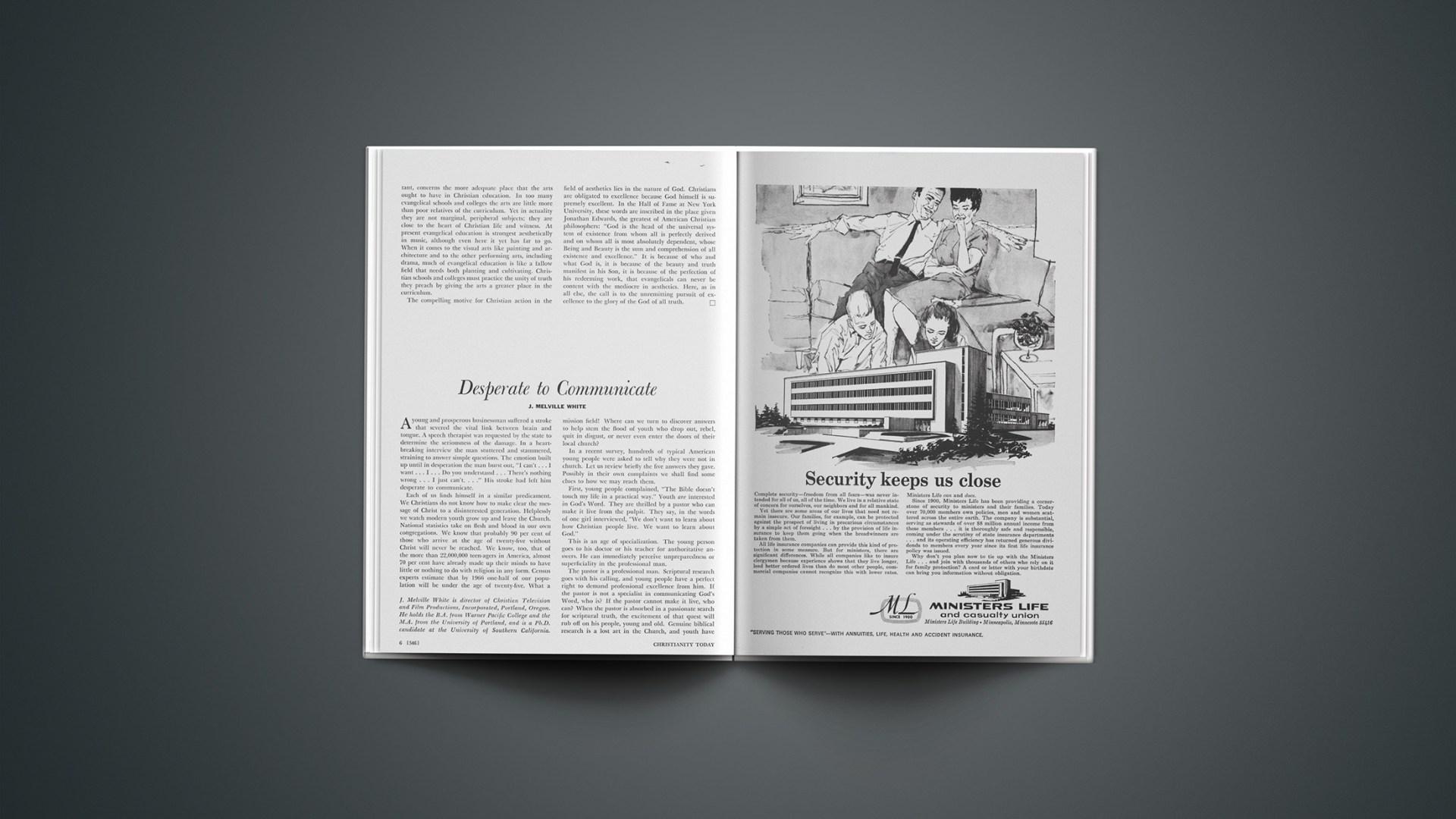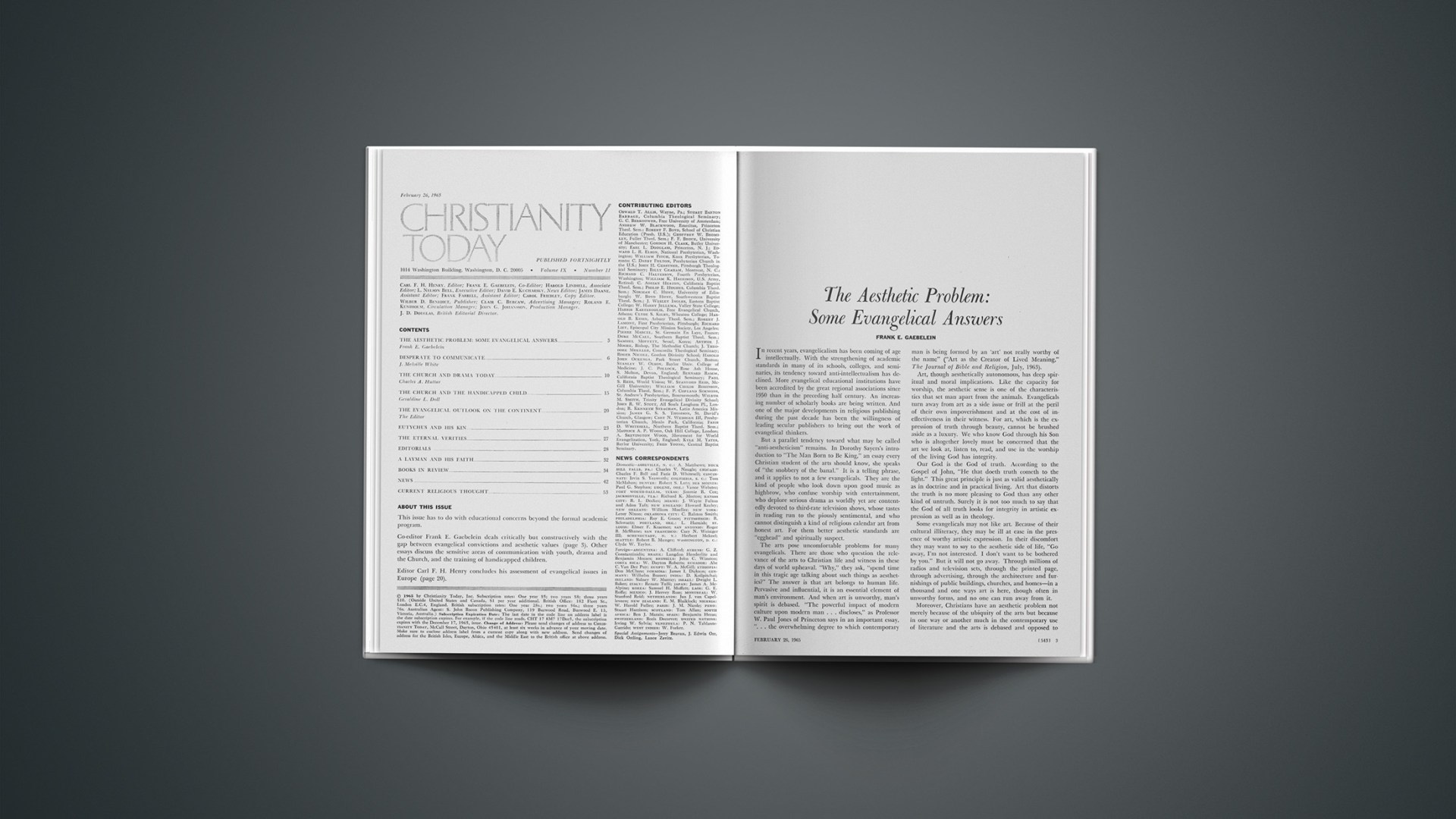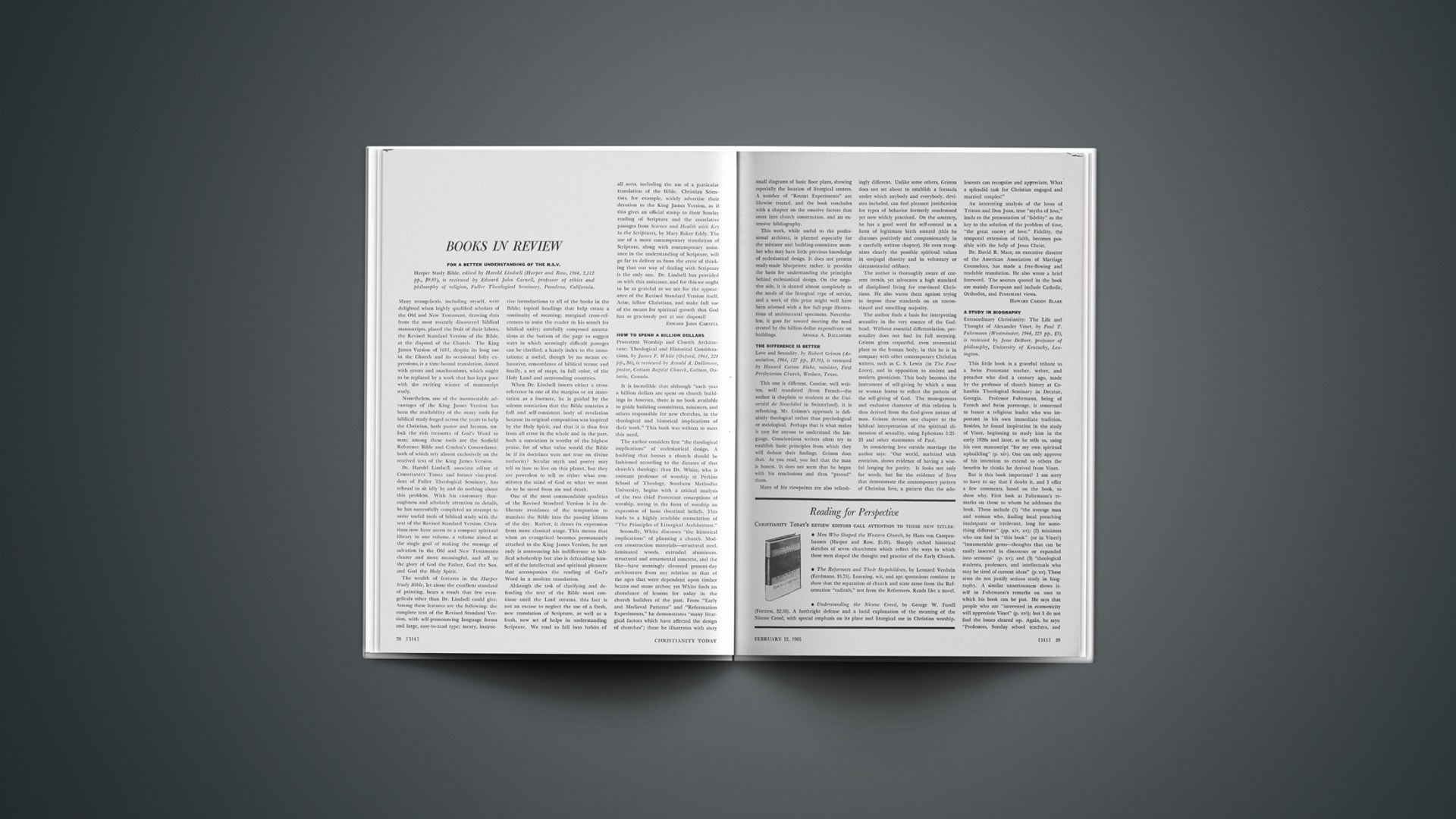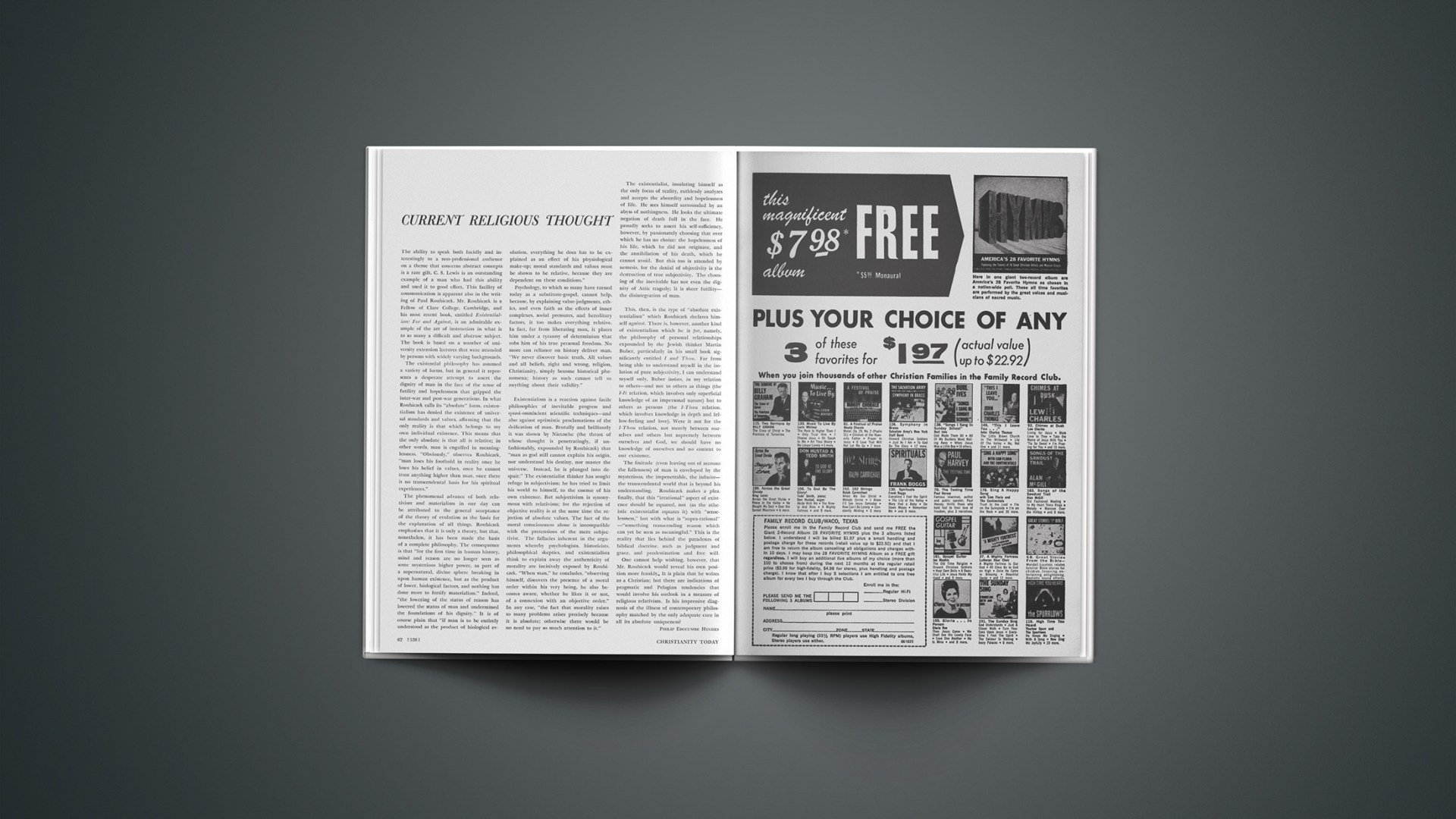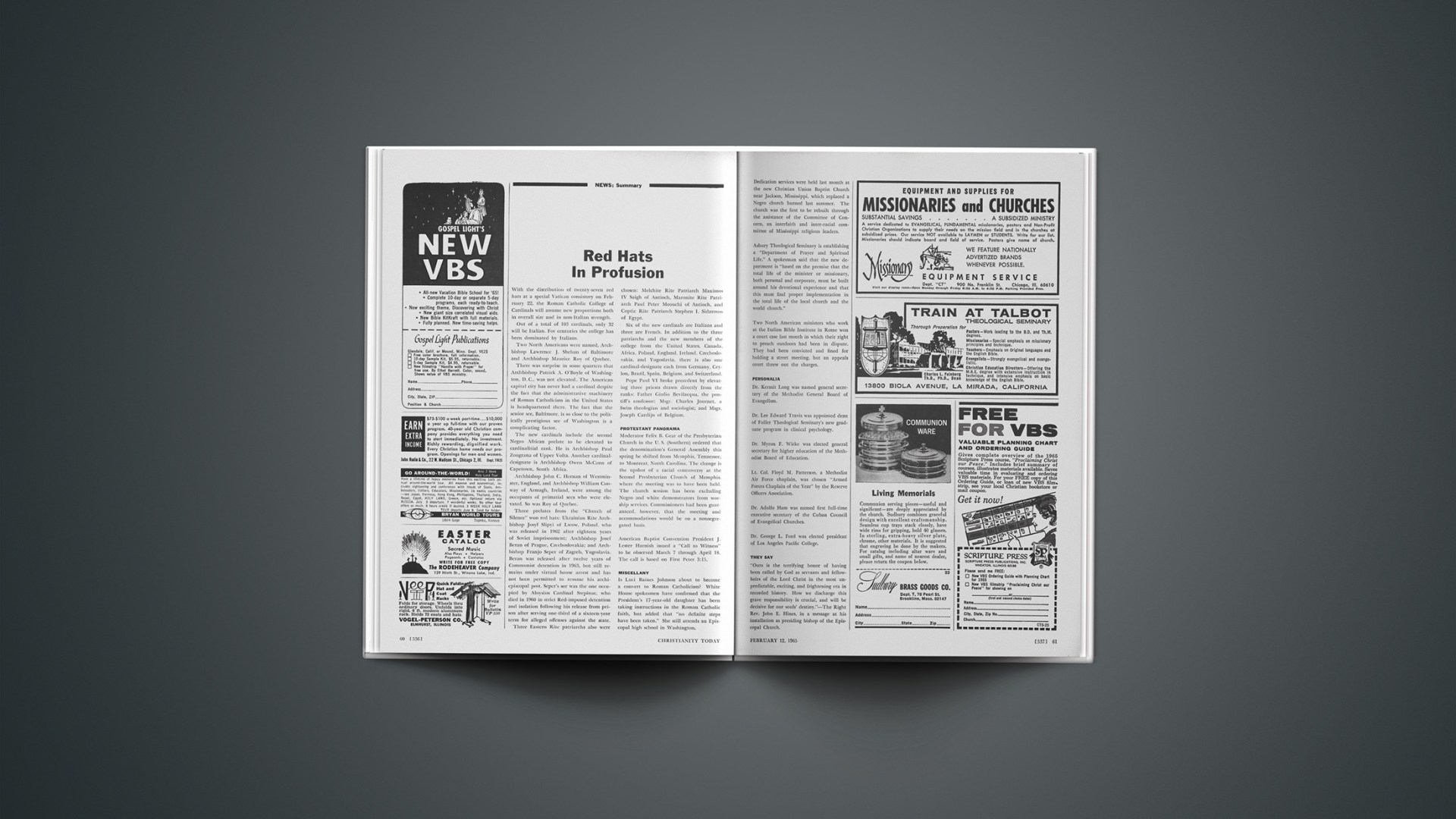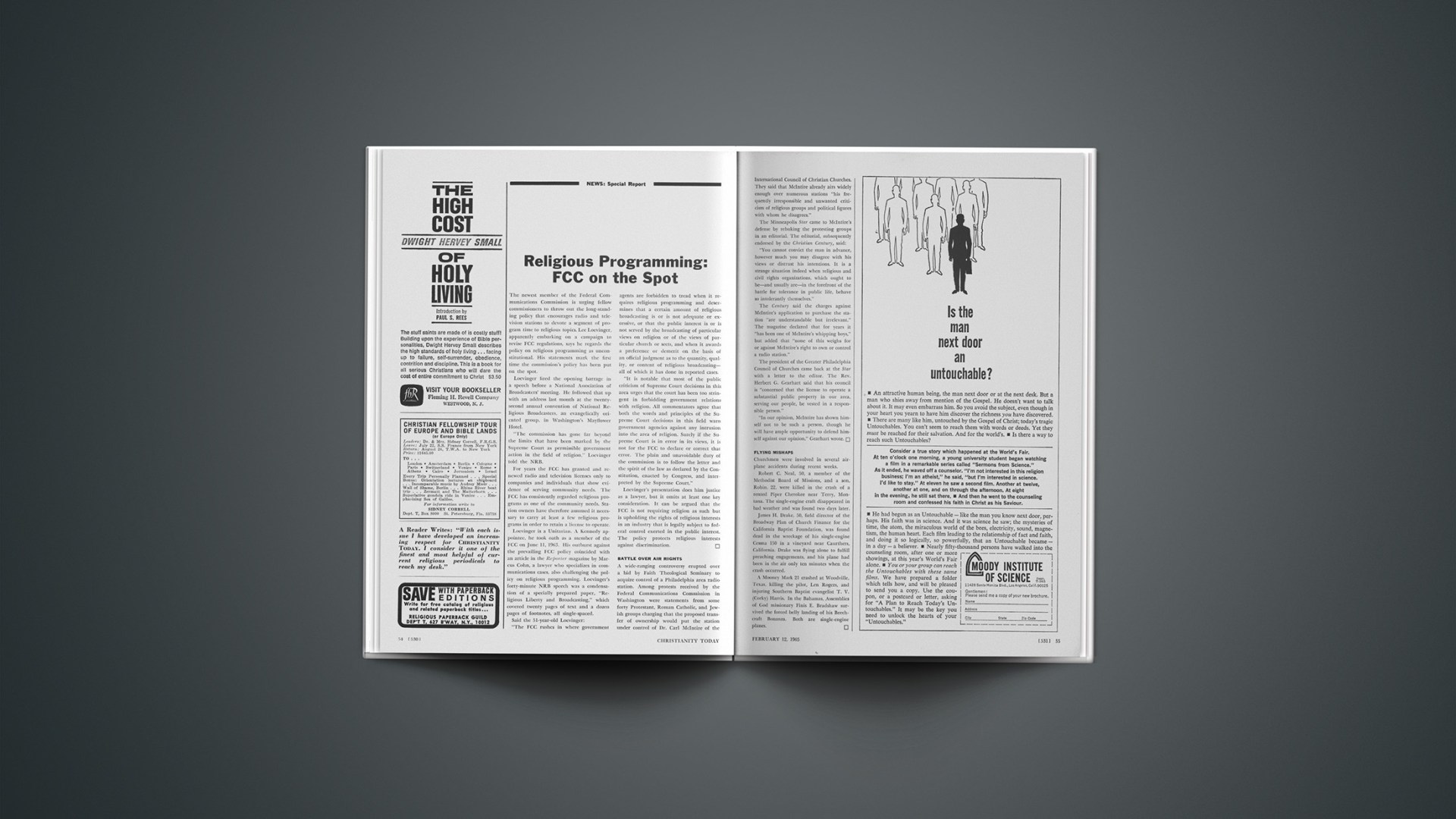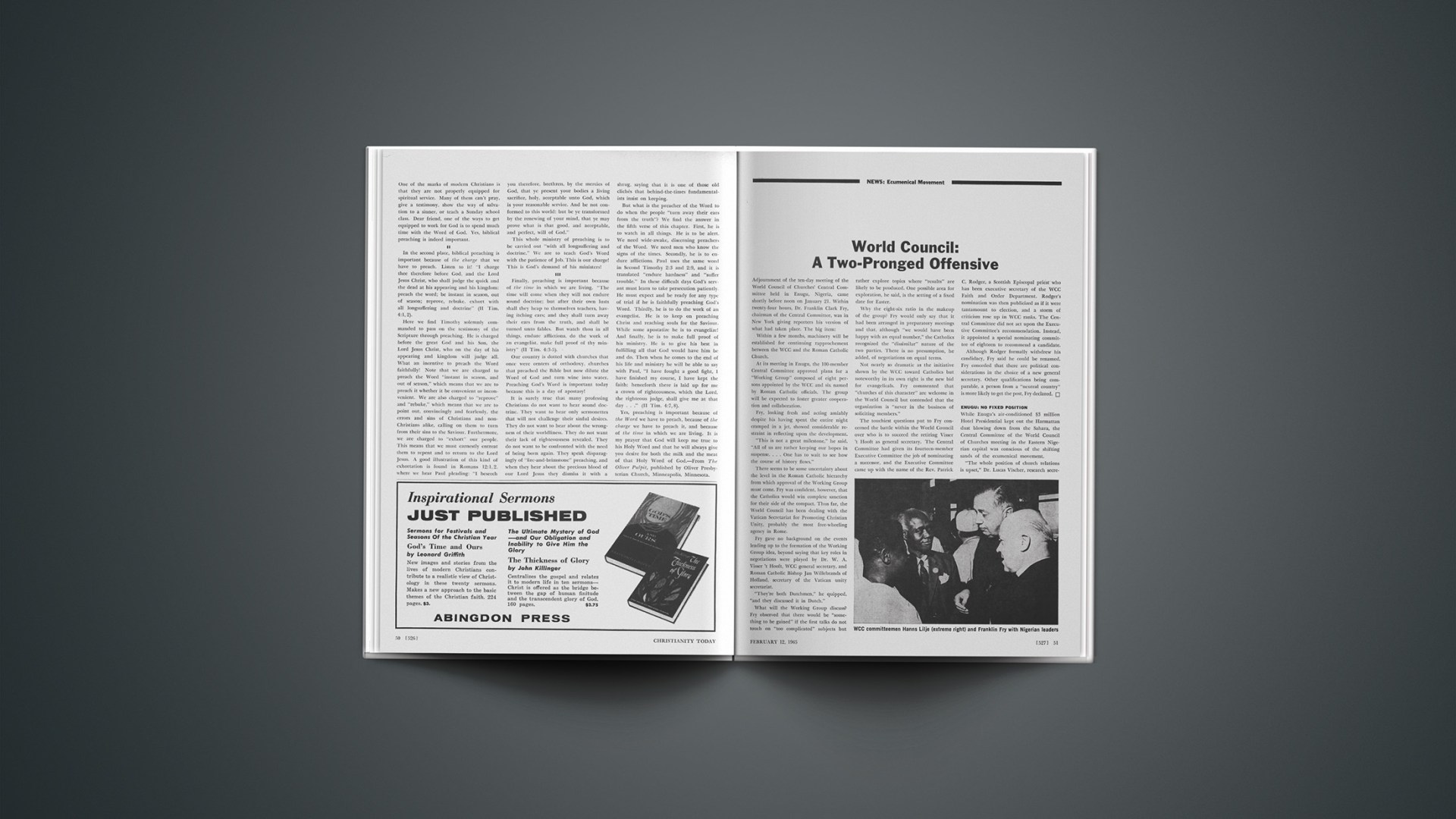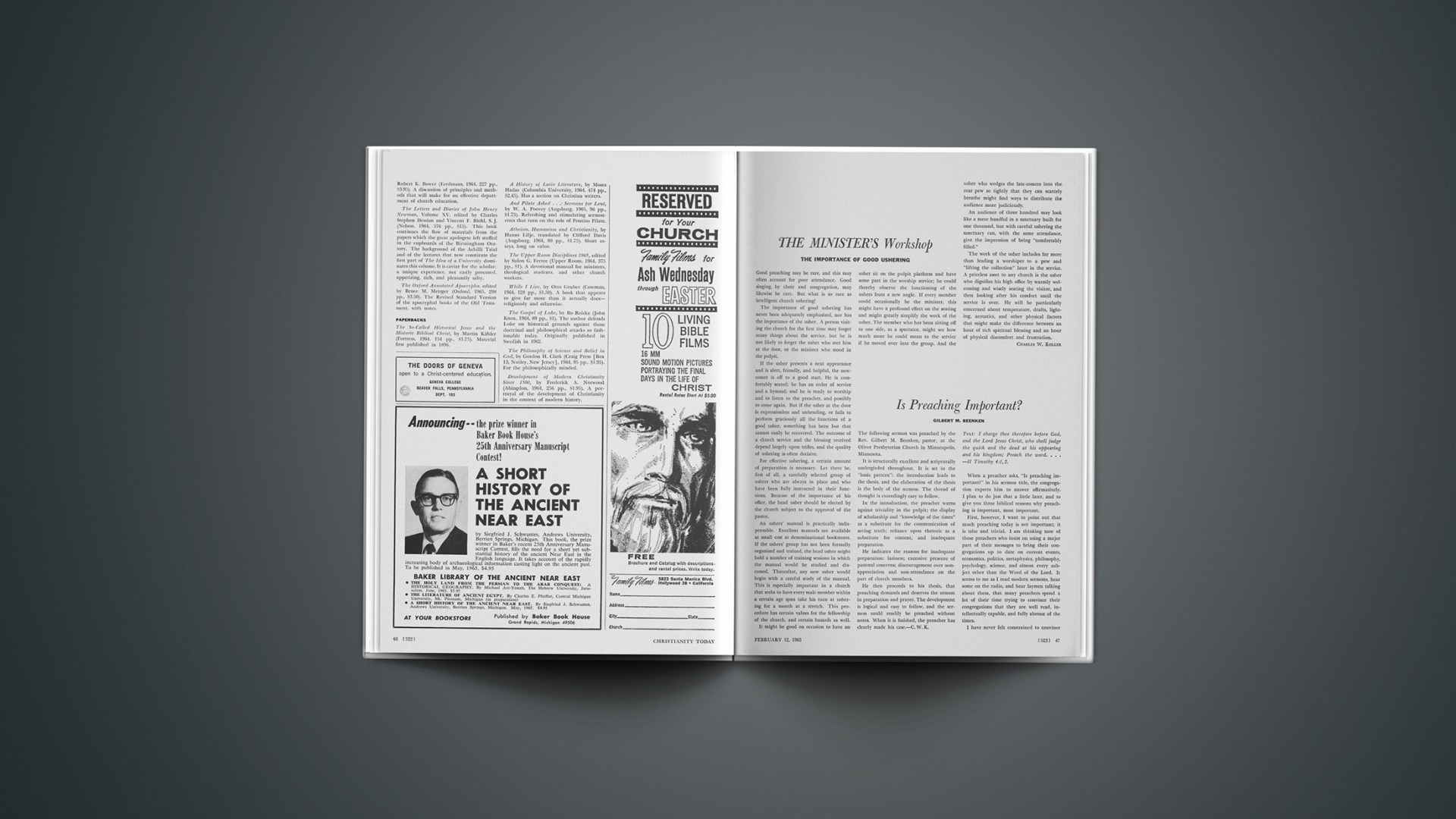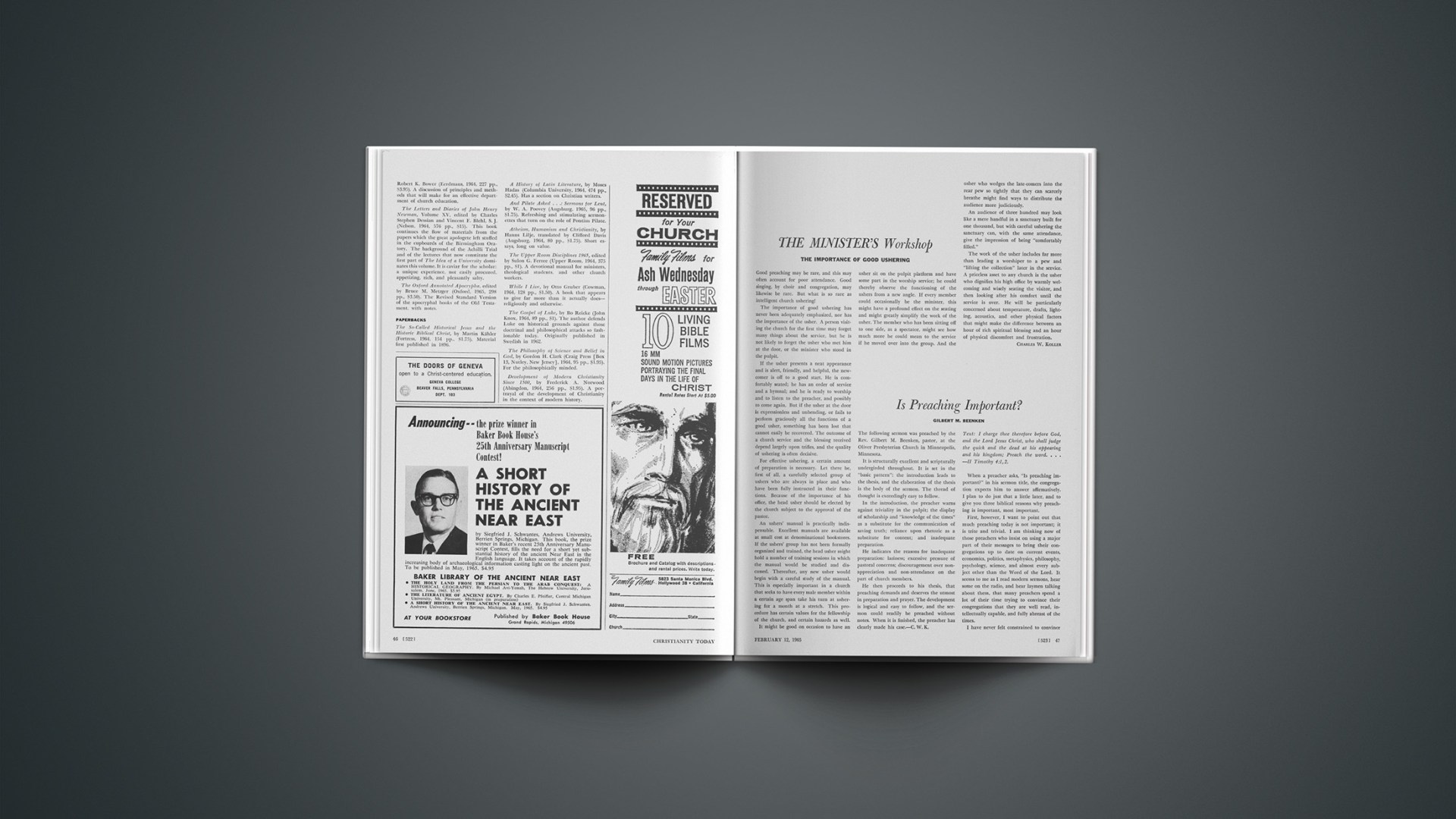And God saw every thing that he had made, and, behold, it was very good.… Every creature of God is good, and nothing to be refused.” “They … worshipped and served the creature more than the creator.… If any man love the world, the love of the Father is not in him.”
The Church has always had to work out its life in the tension of these principles: the goodness of God’s gifts, coupled with our proneness to subvert them and to be subverted by them.
One of his gifts to us is the ability to pray, the capacity for committed and integral exertion. Another is the ability to play, the capacity for detached and aesthetic pleasure. To deny either is to risk falling short of being fully human. Out of both, out of mimicry and mystery, out of laughter and ritual, the theater, in Grecian times, was born. Although it never fully died, its eclipse was so great that one can almost speak—and this is quite remarkable—of a rebirth, following the same pattern, about a thousand years ago under the auspices of the Christian Church.
Pagan survivals reflected in superstition in young Christian cultures, folk entertainment in village and countryside, minstrels, jongleurs—all exerted pressures comparable to those of Broadway and Hollywood today: pressures toward devotion to false gods or complete abandonment of the pursuit of any gods whatever. The medieval Church was able to harness these energies to its own purposes, channeling the torrent, as it were, to drive its mill. This was possible in part because the mighty acts of God recorded in Scripture are inherently dramatic, and so are our acts of worship whether they are viewed as sacrament or as ordinance.
A great flowering of liturgical drama resulted. Earliest was the embellishment of parts of the service itself with costumes, pageantry, gesture, dialogue, role-playing. Then came the great cycles of mystery plays celebrating the macrocosmic history of God’s dealings with mankind, from The Fall of Lucifer to The Judgment. Miracle plays sought to honor God in another way, showing him at work in the lives of the saints.
In the fifteenth century, as a response to a shift in devotional theology (perceptible also in art and literature), morality plays such as Everyman focused on the microcosmic history of the individual soul from birth through the vicissitudes of life to ultimate salvation.
As early as the fourteenth century, religious reformers were condemning the new drama. “This playing of miracles nowadays is … idolatry”—such is the crowning argument in one treatise (Brit. Mus. MS. Add. 24202). By honoring them above sermons, thus implying “that such playing doeth more good than the Word of God when it is preached,” men “say blasphemy.” The Puritan attack in England reached its height around 1580 and again in the Civil War, resulting in the closing of the theaters in 1642.
True, the theater was then no longer under the aegis of the Church. In some ways it was making the most of its independence. Undoubtedly 1642 stamped out some evils—temporarily.
Yet at the same time the religious heritage was a powerful influence on Elizabethan drama. One of the finest specimens, Marlowe’s Doctor Faustus, belongs unmistakably to the morality play tradition. Marlowe “presents us with the paradox of a man confessedly irreligious using a religious theme to write a masterpiece of religious drama” (R. Speaight, The Christian Theatre [Burns and Oates, 1960], p. 48). Written at a time when a Christian world-view was still, for most people, viable, the best plays of the age—Shakespeare’s included—show us the heights literature can reach within such a framework.
To continue a history of Christian drama we should turn to seventeenth-century Spain and France; but this is not our aim. We live in a world many call “post-Christian.” What relation can there be between Church and theater in such an age? Contrariwise, we see a revived use of drama in the work of the Church and a revival of religious values in the theater—after two centuries of divorce. What are the implications of these trends?
Christian significance is found in three different kinds of modern drama. Some plays have a clear, direct Christian message; others have an indirect one; still others are written on religious themes but lack Christian insight.
When the term “religious drama” is used, it is often limited to the first type. Here we are closest to the kerygma, and the trumpet must sound clear. Most of these plays are used primarily by, if not in, churches.
To Group 1 belong plays analogous to the various forms of medieval drama. Many of them are basically homiletic, only a step away from the pulpit. Elements of plot and characterization are undeveloped, the emphasis being rather on the epigrammatic proclamation of a message and perhaps on pageantry. Historical vignettes may be loosely linked by the device of a narrator. Dramatic force may be lent to passages of Scripture by an arrangement for speech choir or for several speakers. This dialogue of Dusty and Rusty in James Broughton’s The Last Word partially illustrates the style:
It’s cold in here.
United Nations, have mercy upon us!
Elizabeth Arden, deliver us!
General Motors, have mercy upon us!
Sigmund Freud, deliver us!
Batten Barton Durstine and Osborn, have mercy
upon us!
In the name of Mutual Life and Cold Storage.
Amen.
Silence
There’s no answer.
The Mysteries Today
The mystery play, reenacting Bible stories, has its analogues today. Modern stagings of the medieval mysteries themselves have contributed to the current upsurge of religious drama. At the annual Festival in York, England, the pageants are carted through the streets much as they were centuries ago.
But the medieval versions, though still very much alive for us, are not enough. The old story, ever new, each age must retell in its own way. Striking parallels between the world of Herod and that of Hitler are at the heart of W. H. Auden’s Christmas oratorio, For the Time Being; but that work is more poetic than dramatic. The same sort of thing was done dramatically by Stephen Vincent Benet in A Child Is Born. Dorothy Sayers’s BBC radio series on the life of Christ, The Man Born to Be King, is a more sustained effort. Those who have written with distinction in the genre of the modern biblical play make a long list—too long (as with the other categories) for me to attempt to include it here. Andre Obey, Henri Gheon, Charles Williams, and Ronald Duncan are outstanding.
Philip Turner’s Christ in the Concrete City (1953) is an interesting blend of the kerygmatic with the narrative approach. Its powerful evocation of Passion Week, ending with the Resurrection, owes something to the epic theater of Bertolt Brecht as well as to T. S. Eliot.
Signs Of Sanctity
If Bible stories have their perennial appeal, the lives of saints are also fascinating. As the term “miracle play” indicates, the Middle Ages emphasized the supernatural signs by which saints were identified. From there the pendulum could only swing toward discrediting these signs, and growing adeptness in psychology encouraged entirely human explanations for “saintliness.” But now, no less interested in understanding them as people, our age is again ready to recognize the saints. Sanctity is recognized to be as much a human possibility as adultery—and very nearly as interesting, to a public which has perhaps had enough of the latter to be bored with it.
The definitive study of the saint in modern drama is Eliot’s Murder in the Cathedral, produced at Canterbury in 1935 just a few steps from the scene of Thomas Becket’s assassination in 1170. In the subtlety of its character analysis, Eliot’s study of martyrdom—of the meaning of “bearing witness”—meets the highest demands of the art.
Of several worthy successors in this genre, three may receive particular mention. Christopher Fry wrote The Boy with a Cart in 1939 expressly for church presentation. But the recent play of Robert Bolt, A Man for All Seasons, is proof enough that the appeal of the saint, even when presented as heroic, is not limited to ecclesiastical precincts. A saint closer to our own times, the great Baptist missionary Adoniram Judson, is the subject of Albert Johnson’s Conquest in Burma.
In the morality play, abstract moral and theological concepts or representative figures (e.g., Everyman) are given personality and made the protagonists in a drama. The idea has a medieval aroma about it, but Guenter Rutenborn in The Sign of Jonah has succeeded in giving it an unmistakably modern treatment. So has Charles Williams, whose Grab and Grace pits Pride and Hell against Faith, Grace, and Gabriel, with Man as both the object of contention and the one who must decide. Such a lineup could be dull, but the play turns out, on one level, a rollicking farce. Fry’s A Sleep of Prisoners is another play that has strong ties with the morality tradition.
With the emphasis of the moralities on the proclamation of abstract truth, we have come full circle and are again close to the homiletic style.
To Group 1, plays with a clear, direct Christian message, also belongs a class of purely fictional dramas. Here plot and character development must carry the weight, and they can do so superbly. For God has the answer to every problem of man: this is surely implicit in the Christian “good news.” Set the problem, then, as realistically as art can do it, and let the answer be worked out.
For example, Cry the Beloved Country by Felicia Komai (from Alan Paton’s novel) faces the problem of race; The Zeal of Thy House by Dorothy Sayers, that of the artist and morality; Turner’s Cry Dawn in Dark Babylon, that of a child’s death. Turner says he found that the Christian symbolism he had used in Christ in the Concrete City was not meaningful to a “post-Christian” audience; “I have therefore asked the questions in terms of a human story.”
A second significant group of modern plays comprises those in which Christianity is positive but veiled. These are the plays we associate more closely with the commercial theater than with the Church.
An indirect evangel rarely wins converts. I should be surprised to hear of anyone’s being led to Christ by T. S. Eliot’s The Cocktail Party. That is not its purpose. The value of the Christian message obliquely presented is that it can gain a hearing where the direct evangel is shut out. Its accomplishment (setting aside the purely literary and aesthetic and concentrating on what pertains to the Church’s work) is the creation of an atmosphere of presuppositions and expectations in which a Christian message may be received. The plays of Group 2 may be welcomed as a praeparatio evangelii.
A Mysterious ‘Cure’
The Cocktail Party, enormously popular in New York and London, is perhaps the best example of this group. Four well-to-do and creative people whose lives are badly mixed up are “cured” by a trio of mysterious acquaintances, one of whom is a psychiatrist. The average theater-goer who found himself watching The Cocktail Party was reassured by a familiar situation and deft comedy lines. He was not put entirely at ease, however, for once Eliot’s strategy had captured his audience there were deviations from the theatrical formula. The “psychiatrist” concluded each office call with a little ceremony that was uncomfortably like a liturgy. Strange words like “sin” and “atone” were used—apparently with the author’s approval—to diagnose the needs of one patient; and her “cure” was to become a missionary and to die, in a native uprising, by crucifixion.
Some viewers doubtless missed these hints and were entertained. Others must have felt that the playwright, obviously trying to do something to them besides provide an evening’s entertainment, had betrayed them. But what he was trying to do was not exactly plain—not clearly enough Christian to trigger the defense mechanism of rejection that many seem to have developed. Eliot went on to repeat this strategy in other plays.
Another author of dramas that are markedly Christian in this way is Christopher Fry. His play, The Lady’s Not for Burning, is a fine example. To attempt to communicate directly in theological terms with many of our contemporaries is to fail to communicate at all. This is a major problem of the Church. Perhaps Eliot and Fry point the way.
Modern plays belonging to the third group cannot be described as “Christian,” even indirectly, but nevertheless deal significantly with religious themes. Interpreting the word “religion” broadly—for which there is New Testament as well as Tillichian authority—we are offered the definition of “religious drama” as that which “seeks to relate man to the totality of his being” (H. Ehrensperger, Religious Drama: Ends and Means [Abingdon, 1962], p. 67).
At any rate, the fact that popular interest in their themes has sustained such recent plays as The Deputy, J. B., Gideon, Anouilh’s Becket, The Crucible, The Visit, Waiting for Godot, and Long Day’s Journey into Night is significant to the Church. It is not entirely a contemporary phenomenon. Shaw’s Saint Joan and O’Neill’s Lazarus Laughed are examples from earlier in the century.
Reading For The Questions
Some may prefer to call this play or that play Christian and move it from Group 3 to Group 1 or 2; I will not argue. What the plays I have just mentioned have in common is a clear and honest presentation of a problem that is religious—individual or social guilt, personal emptiness or despair, the cry for salvation. Many church study groups find this a good starting point; they read Ionesco and Tennessee Williams and Arthur Miller and Duerrenmatt and Sartre, profitably—not for their answers but for the questions inescapably posed in their treatment of a fallen humanity. The catalogue could go on, for every serious drama delves into questions into which it is also the Church’s obligation to probe.
Not that the value of the answers offered is always—or ever—nil. Marvin Halverson’s remarks on D. H. Lawrence’s David are interesting: “His employment of Biblical imagery penetrates to the heart of meaning. While one might credit this freshness of insight to Lawrence’s powerful imagination, it is also testimony to the renewing power of the Biblical image itself” (Religious Drama I [Meridian, 1957], p. 8). We have, perhaps, a situation close to that of Marlowe’s Faustus.
An encouraging aspect of the popularity of such plays is that there may be a growing readiness in our culture to face religious issues and to admit that they are religious issues.
This last group of plays leads us to note what may be the most important point of all in the modern dialogue of Church and theater: the discovery that theological meaning lies at the root of the very concepts of tragedy and comedy. Modern Western civilization, guilt-ridden and threatened with extinction, is developing an openness to the concepts of sin and the suffering Saviour. Many Christian scholars, the Chicagoan Nathan Scott perhaps foremost, see tragedy itself as an expression of these concepts. But Christian hope provides another perspective. The world we live in is enough to cause despair, were it not for “the narrow escape into faith.” That is Fry’s description of comedy.
How should the Church today consider drama? With concern—and open-mindedness; as a challenge and an opportunity.



